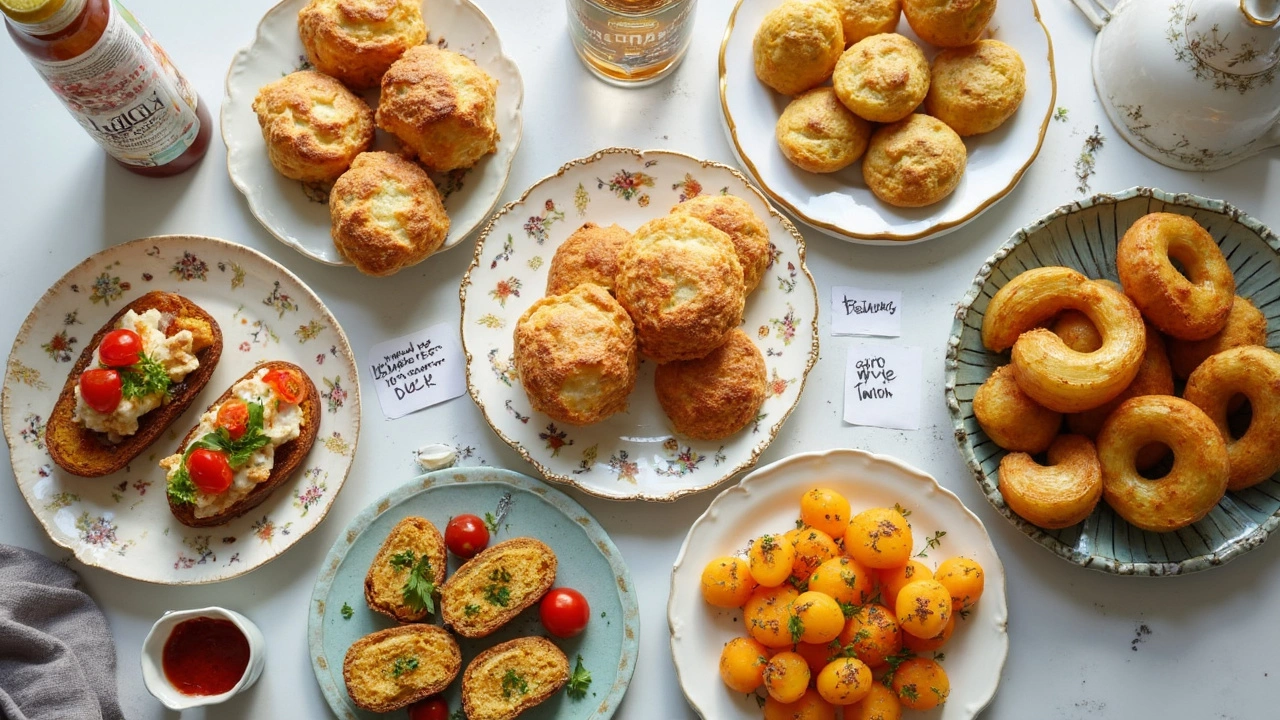If you’re cutting gluten or just thinking about it, you’ve probably wondered if you can eat potatoes without worry. Here’s the deal: potatoes themselves don’t have gluten. The confusion usually starts because lots of foods that show up with potatoes—like fried or battered stuff—can be loaded with gluten from flour or seasonings. The potato at its core? Totally gluten-free.
Why does this matter? For anyone with celiac disease or a gluten sensitivity, mixing up which foods have gluten can lead to serious discomfort. Not cool, right? Sticking to the basics, natural potatoes (think russet, red, Yukon Gold, or sweet) are safe. Problems pop up once processing or cross-contamination happens. That’s why homemade mashed potatoes or baked spuds are winners, while restaurant fries might be a gamble unless you know what they’re cooked with.
- What Is Gluten Anyway?
- Do Potatoes Really Have Gluten?
- Why Potatoes Are a Gluten-Free Staple
- Common Mistakes to Avoid Cooking with Potatoes
- Easy Ways to Use Potatoes in Gluten-Free Recipes
What Is Gluten Anyway?
Gluten gets a lot of attention, but what actually is it? Gluten is a protein found in certain grains—mainly wheat, barley, and rye. It gives bread that soft, chewy texture most people like. When you knead dough for pizza or bake a cake, gluten is responsible for making things stretchy and helping food hold its shape.
Here’s the kicker: gluten is only naturally present in those grains. It's never in potatoes, rice, corn, or most fresh fruits and veggies. That’s why if you’re going for a gluten free recipe, stuff like plain potatoes are fair game—but bread, pasta, or anything with flour, not so much.
You can actually find gluten hiding in a lot of packaged foods: salad dressings, soy sauce, even some soups. Companies sometimes use wheat as a thickener or filler, so always check food labels if you’re trying to avoid gluten for medical reasons.
| Grain | Contains Gluten? |
|---|---|
| Wheat | Yes |
| Barley | Yes |
| Rye | Yes |
| Oats* | Sometimes* |
| Potato | No |
| Rice | No |
*Oats don’t have gluten naturally, but most get contaminated with wheat during processing. Look for “certified gluten-free” if you want to be extra careful.
The big takeaway here—gluten only hangs out in some grains, not in potatoes or plain veggies. So when you’re making gluten-free swaps, keep an eye on ingredient lists and stick to the basics when in doubt.
Do Potatoes Really Have Gluten?
This might surprise you, but potatoes don’t naturally contain gluten at all. Gluten is a protein you find in wheat, barley, and rye—three grains that potatoes don’t have anything to do with. So, if you’re reaching for a potato in the produce aisle, you’re picking up a 100% gluten-free food.
Here’s where things get messy: what you add to potatoes or how they’re processed can sneak gluten right into your meal. Store-bought potato dishes (like frozen fries or shredded hash browns) sometimes include wheat flour or other fillers to help with texture or crispiness. Always check those ingredient labels like your health depends on it—because for people with celiac disease, it really does.
Also, let’s talk about cross-contact. When potatoes are cooked in the same oil as breaded foods, gluten can tag along for the ride. That means most fries at fast food places aren’t a safe bet if you need to steer clear of gluten, even though the main ingredient is just a humble spud.
- Fresh potatoes: always gluten free
- Potato chips and snacks: check ingredients for wheat, barley, or rye
- Mashed or baked potatoes made at home: safe if you skip gluten add-ins
- Restaurant or packaged potato dishes: ask about prep methods and hidden gluten
If you’re ever unsure, stick to whole, unprocessed potatoes. You’re in the clear with those. Bottom line: potato itself is naturally gluten free, but you need to watch what else jumps into the dish.

Why Potatoes Are a Gluten-Free Staple
Potatoes earn their spot in just about every gluten-free kitchen for one simple reason: they’re naturally safe. No weird proteins, nothing hidden. The potato is basically just water, carbs, vitamins, and minerals. That makes it easy for people with gluten issues to trust. Even if you’re not a pro in the kitchen, there’s not much you can do to mess up a simple boiled or baked potato.
Another thing that makes potatoes great? Their versatility. You can mash ‘em, roast ‘em, bake ‘em, or turn them into fries at home—all without flour or other gluten ingredients. Lots of gluten-free recipes use potatoes to fill the spot of bread, pasta, or even pizza crust. Ever had a potato-based pizza? Seriously, it’s a thing, and it works.
If you’re worried about nutrition, potatoes come with more in the tank than you might think. Check this out:
| Potato Type | Calories (per 100g) | Vitamin C (% DV) | Potassium (mg) |
|---|---|---|---|
| Russet | 79 | 15% | 429 |
| Red | 70 | 13% | 411 |
| Sweet | 86 | 21% | 337 |
They beat most grains at potassium and vitamin C content. That’s a bonus when swapping out gluten-dense stuff for something that actually adds value to your meal.
People shopping for gluten free foods know the struggle of finding safe options. Potatoes take the stress out of it. They’re easy to cook, cheap, and filling, which is a huge deal for anyone sick of overpriced gluten-free breads.
- Always scrub or peel potatoes to avoid dirt or pesticide residue.
- Double-check sauces, toppings, and anything ‘added’ for hidden gluten.
- If you’re buying frozen potatoes (like fries or hash browns), read the ingredient list. Some brands add wheat flour as a coating.
Potatoes are the old-school, no-brainer solution for anyone ditching gluten. They just work.
Common Mistakes to Avoid Cooking with Potatoes
It’s easy to mess up potatoes without even realizing it, especially when you’re trying to stick to gluten free eating. Here’s what trips most people up and how you can dodge those mistakes.
- Gluten sneaks in when you use store-bought seasoning packets or soup mixes. Lots of them contain wheat flour or barley. Always check the ingredients or just stick with your own blend—simple salt, pepper, garlic, and herbs work great and keep your meal safe.
- If you’re making fries or roasted potatoes, watch out for the oil. Some folks reuse oil after frying battered foods (like onion rings or chicken tenders), and that makes cross-contamination super likely. Use fresh oil and your own cookware if you’re sensitive.
- At restaurants, “crispy” potatoes sound harmless, but often those are covered in a flour-based coating before hitting the fryer. If you don’t ask, you might end up eating something you shouldn’t.
- Instant mashed potatoes seem convenient, but tons of brands add wheat starch to improve texture. The safe play is real, whole potatoes—mash them yourself, and you’ll know exactly what’s in them.
- Don’t forget about gravy or sauces. Classic potato dishes often come with gravy thickened with flour or mixes that might hide gluten. Swap in cornstarch or arrowroot to be sure it’s gluten free.
Here’s a quick breakdown of common products and their gluten status when it comes to potatoes:
| Potato Item | Usually Gluten Free? |
|---|---|
| Plain raw potatoes | Yes |
| Homemade mashed potatoes | Yes |
| Restaurant fries | Ask! Often cross-contaminated |
| Instant mashed potatoes (boxed) | Check label |
| Frozen tater tots | Label may say gluten-free, but always check |
Stay sharp—read those labels, ask questions, and keep your kitchen tools dedicated for gluten free cooking. Potatoes can be safe and easy if you know the sneaky spots to watch.

Easy Ways to Use Potatoes in Gluten-Free Recipes
Potatoes are a lifesaver when you’re ditching gluten—they’re cheap, filling, and work in all kinds of meals. The best part? You can swap them into classic comfort food recipes and barely notice the difference. Here’s how to put these spuds to work in your kitchen.
- Gluten free pizza crust: Mash cooked potatoes, mix them with egg and a little cheese, press it all out on a baking tray, and bake until golden. Top it off and slice like any regular pizza.
- Homemade hash browns: Shred potatoes, squeeze out the moisture, and cook them up in a skillet. No flour needed—crispy on the outside, soft inside.
- Potato-based gnocchi: Use mashed potatoes, gluten-free flour (like rice flour), and an egg. They’re soft little dumplings that sit perfectly with sauce.
- Swap for breaded coatings: Instead of using breadcrumbs, crush potato chips (make sure they’re gluten-free) to coat chicken or fish before baking or frying.
- Loaded baked potatoes: Pile on toppings like cheese, beans, salsa, or even leftover chili for a one-dish meal that feels indulgent but stays safe.
If you want to get a little fancy, you can even make potato pancakes or rosti—just mix grated potatoes with onion, a bit of gluten-free flour, form patties, and fry them up. They work at breakfast or as a side dish for dinner.
| Gluten Food | Potato Alternative |
|---|---|
| Bread | Baked potato, hash browns |
| Pasta | Potato gnocchi, potato ribbons |
| Pizza crust | Mashed potato crust |
| Breadcrumbs | Crushed potato chips |
One quick tip: Always check store-bought potato products for sneaky gluten-filled additives. Plain frozen fries and tater tots can sometimes have wheat added, so read those labels. The more you cook from scratch with real potatoes, the safer—and tastier—you’ll be.

